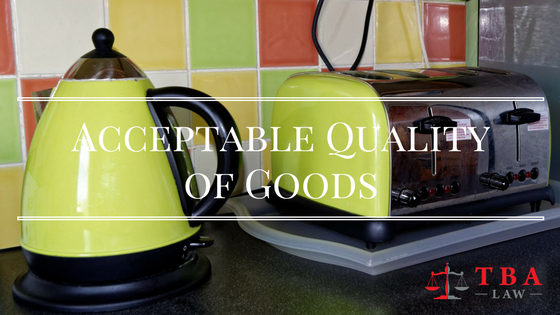Acceptable Quality for Goods
Avid readers of our resources page will recall the introductory article on the Australian Consumer Law. It listed the nine consumer guarantees, and discussed what constitutes a major failure. This article outlines the first of the nine guarantees – that goods are of acceptable quality.
The acceptable quality test
This may seem self-explanatory, but it is worth some discussion. Suppliers and manufacturers of goods guarantee those goods to be of acceptable quality. But what does this mean to the consumer? As a general guide to whether goods are of acceptable quality, we need to ask:
• Are the goods fit for the purposes they are commonly supplied for?
• Are they acceptable in appearance and finish?
• Are the goods free from defects?
• Are the goods safe?
• Are the goods durable?

When applying the above test, you must have regard to the nature of the goods, the price of the goods, any statements on the packaging, any representations made by the seller at the time of the sale, and any other relevant circumstances.
If you purchase a new kettle for $300.00 you would expect the it would last longer than one purchased for $30.00. However, if the kettle leaks from the bottom, cannot heat water hot enough to boil, sparks when the on button is depressed, or only lasts for two weeks, there is an excellent chance the kettle would not be of acceptable quality.
Second hand goods are also covered by the guarantee, however their age, price and condition at the time of the second-hand sale will influence the standards when applying the above test. For example, a second-hand fridge sold as ‘three years old and in good condition’ would be expected to keep food and beverages cold, not catch on fire, and last a while. If it broke down one month after purchase, it would likely not be acceptable quality.
However, there are some circumstances where the guarantee of acceptable quality will not apply. If the consumer causes the defect or uses the goods in an abnormal manner, a reasonable examination of the goods should have revealed the defect, or the supplier informs the consumer of the defect prior to sale, the guarantee will not protect you.
For example, if you drop that kettle into a sink of soapy water and leave it submerged to ‘clean the heating element’, or you boil your spaghetti in the kettle because you cannot find a saucepan, you will probably void your consumer guarantee.
Similarly, defective goods can be sold if the supplier informs the consumer of the defect. This is often the case with ‘seconds’ or ‘broken goods’ that are heavily discounted due to the problem. Second-hand antiques sold ‘as is’ often have a number of defects, however if a consumer can examine the goods prior to purchase and should reasonably be able to see the defect (a broken mirror or faded paint, for example), then the guarantee does not apply. Bargain hunters beware!
Remember, your remedy will depend on whether the defect constitutes a major failure or not. In some matters, you will be entitled to a refund or replace, where in other matters you may only be entitled to a repair.
[maxbutton id=”2″ ]
Example 1
I bought a dress on a ‘seconds’ rack. The tag affixed to the dress advised that there is a problem with the buttons maintaining their gloss. It fitted perfectly, but the stitching came loose. Am I covered for this kind of defect?
Yes, because the dress specified the reason it was on a seconds rack, the gloss of the buttons, you could not claim protection under the guarantee for the buttons, but there was nothing about loose stitching, so you may still be entitled to a remedy for that.
Example 2
I bought an antique wooden table at a second-hand store, but when I got it home I noticed the wood was chipped in many places. I didn’t notice it in the shop because I was admiring the shape of the legs instead and didn’t look at the table top. Does the consumer protection apply?
No, this second-hand product was sold ‘as is’ and you had a chance to examine the table before purchase and notice the chips. The chips were not hidden from you. The fact that you didn’t notice the chips in the wood because you didn’t look at that part of the table is no excuse. Next time, be more observant before purchasing antique furniture.
Example 3
I bought a new dish washing machine but it has started leaking when I use it. I paid a lot of money for it and it is only a year old. I have only used it to wash my dishes once a night.
This would be unacceptable quality. A new dish washing machine should last longer than a year. This would not be deemed as durable.
In conclusion
The consumer guarantee of acceptable quality is important in all transactions, and there are many things to remember when determining whether you are protected. What the goods are, how much you paid for them, how you used them, and any representations as to a defect at the time of purchase will all be factors in determining whether a specific defect will fall under the protection.





Leave A Comment